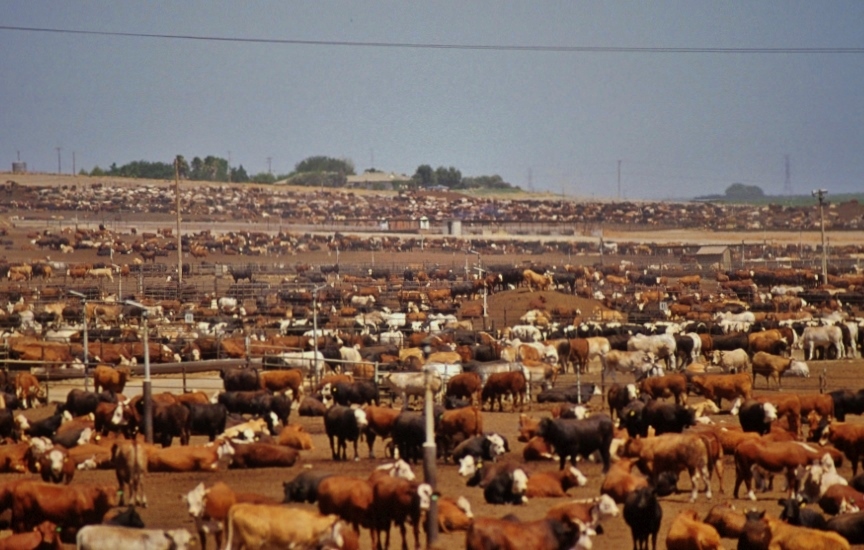A recent documentary, Cowspiracy: The Sustainability Secret, advocates leading environmental organizations must address animal agriculture’s massive impacts to forests, water sustainability, and climate change. Also watch Howard Lyman’s documentary, Mad Cowboy.


Cowspiracy Exposes the Truth About Animal Agriculture
By Ward Pallotta, Published in EcoWatch
In 90 minutes, co-producers Kip Andersen and Keegan Kuhn argue that our institutional and individual attention to selected environmental issues will not make a collective difference unless we also confront the realities of animal agriculture. Animal agriculture’s environmental effects are so pervasive that apparent progress elsewhere cannot counter its destructive and growing impact.
The film suggests why protection for expanded areas of the ocean will not protect oceans or ocean animals. Growing food organically, even on a commercial scale, will not protect the land. Keeping lumber operations out of the Amazon will not save the rainforest. Making homes more water efficient and taking short showers will not make more water available. Driving electric cars will not solve the carbon emissions problem. Installing LED lights and converting to renewable energy will not stop global warming.
Here is some of the data gathered by the producers and woven into this powerful film.
Animal agriculture uses 55 percent of the water in the U.S. US homes use five percent. One thousand gallons of water are needed to produce 1 gallon of milk. Two thousand five hundred gallons of water are needed to make one pound of beef. Growing water shortages make animal agriculture unsustainable.
The Bovine Curtain comes in many forms. Land management agencies like the Forest Service and Bureau of Land Management seldom critique livestock production as a source of ecosystem degradation because they must answer to western politicians who often are ranchers or otherwise associated with agriculture. Similarly, many universities researchers do not investigate the negative consequences of livestock production and are silenced because they rely upon funding from legislatures dominated by Ag producers. — George Wuerthner, The Wildlife News
STORY: Cattle Grazing the Desert Will Not Solve Climate Change
[vimeo clip_id="95436726" width=600 height=338 ]Animal Agriculture: Consuming Land and Ecosystems, Fouling the Climate
Livestock uses 30 percent of the Earth’s total land mass, including nearly 50 percent of the U.S. mainland. The growing demand for animal farmland is responsible for 80 percent of Amazon rainforest destruction. (Palm oil production is second). With 160-million acres cleared or degraded annually for the animal industry, 40 percent of the rainforest will be destroyed in 20 years, affecting species survival and carbon sequestration.
Animal agriculture is responsible for 18 percent of greenhouse gas emissions. All forms of land, air and ocean transportation total 13 percent. Transportation industry air pollution is overshadowed by animal agriculture air pollution. Seventy billion animals are raised annually worldwide. Everyday 144 million animals are killed for food. U.S. farm animals produce 7 million pounds of excrement every minute. Our lakes, oceans and psyches cannot sustain animal agriculture.
Too many environmental groups are dodging this issue, but the cattle industry is steaming. One cattle association blogger reminds its members that it also takes a lot of water to make a T-shirt or produce a car.
Seventy-five percent of Americans consider themselves environmentalists. Only 5 percent of Americans are vegetarian or vegan, however their percentage has quintupled in five years. The average American consumes 209 pounds of meat each year. Everyday, a person that eats a plant-based diet saves 1,100 gallons of water, 45 pounds of grain, 30 sq. ft. of forested land, the equivalent of 20 lbs. of CO2 and one animal’s life.
Whether it was dewatering of rivers for irrigation and its detrimental impacts on fisheries, to the spread of disease from domestic sheep to wild bighorn sheep, from the killing of bison that wandered from Yellowstone Park to opposition to wolf recovery to the continued policy of elk feedgrounds in Wyoming, the ultimate source of the problem was and is livestock. However, the Greater Yellowstone Coalition (GYC) was unwilling to frame the issue that way for fear of antagonizing its board and/or regional politicians. — George Wuerthner
STORY: Soil and Nutrition: No-Till Organics and Carbon Sequestration
httpvh://youtu.be/piZmH4gzyqs
Howard Lyman’s Mad Cowboy
Vegan/Vegetarian Diet = Environmental Sustainability
This issue is an environmental advocate’s dream come true. It requires no political action money, no corporate boardroom decisions, no re-negotiated food policy, no tax incentives. When we eat meat, dairy and eggs, we feed this growing catastrophe. Change will happen as quickly as we convince each other to change what we eat. While producing his film, Kip Andersen became a vegan.
Cowspiracy: The Sustainability Secret was self-funded by the producers and crowd funded via Indiegogo. The marketing efforts for the film depends on community organizations to sponsor the film, promote ticket sales through their networks and fill a local theater. They bear no cost, only effort, and it is working. Cowspiracy showings are accelerating all over the country—during the last two weeks in October, the film will be seen in 35 locations.
Click here for a list of upcoming events or to host a screening.
Ward Pallotta is retired from social justice, nonprofit fundraising in Cleveland, Ohio. He and his life partner, Ann Urick, are members of VegSarasota and Transition Sarasota in Sarasota, Florida, and are advocates for safe and healthy food. Nine years ago they realized they were eating dangerously and switched to a plant-based diet.
Reposted with permission from EcoWatch.













Jamilla Zane from SF Weekly: The claims that cows are our biggest source of greenhouse gas is both untrue and presented in a misleading fashion. The IPCC, a UN panel made up of thousands of scientists, representing 97 countries, has made it incredibly clear that the burning of fossil fuels is the greatest contributor to climate change by far. It directly emits co2 into the atmosphere, which is less dense than methane, but accumulates and stays in the atmosphere for up to 200 years – so you can see why this period of rapid industrialisation holds a lot of unknown consequences for the environment. Methane on the other hand, is more dense, but stays in the atmosphere only for around 20-30 years and does not hold the extreme and cumulative warming potential of fossil fuels. While agriculture is not good for the environment in terms of water, land use, methane and land change – it is certainly not a ‘conspiracy’ that environmentalists are ignoring, nor is it the primary source of emissions fuelling dangerous climate change..
Steven Zwick in Examiner.com: Cowspiracy, like the movie 2016 Obama’s America on the far right (or Michael Moore films on the left), uses “facts” and talking heads to further the filmmaker’s particular agenda. Under the guise of concern for climate change, Cowspiracy’s agenda is pretty clear: it’s to promote abolitionist veganism which is pretty much fundamentalist veganism meaning it allows for no compromises. Abolitionist vegans want to get rid of all livestock. To that end, the film even goes so far as to ironically borrow industrial cattle industry talking points almost verbatim to argue against any alternatives, in particular smaller pastured cattle ranchers, by quoting abolitionist vegan activist and NYC urbanite Demosthenes Maratos (aka @nycVeganPunk) while glibly dismissing Allan Savory along with methods Savory champions including carbon sequestration, methane oxidation and holistic management. (Methods that all help against climate change that use cattle in an environmentally beneficial way). The industrial cattle industry uses their talking points against small ranchers since small ranchers critique their industrial systems (especially input intensive environmentally unsound ones) and take market share by providing consumers with a more ethical and environmentally friendly alternative. (So no, contrary to the communications director, NYC vegan punk’s, bold-faced lie, pastured cattle are NOT worse for the environment because they live longer. Cattle managed properly may be used to help combat climate change especially by being an integral part of a system that sequesters carbon and methane into healthier soils- see Cows Save the Planet by Judith D. Scwartz).
Steven Zwick in Examiner.com: In regards to “facts” Cowspiracy starts by referring to the 2006 FAO long shadow report. Though the film fails to refer to the more recent 2013 revisions to that report that lower the prior report’s livestock emission numbers , and states that agricultural emissions can be cut additional 30% with better management practices. So essentially the movie starts with an often quoted, but still a false premise. The movie than goes on to reference numbers from the late vegan activist Robert Goodland’s 2009 World Watch report that haven’t been widely accepted by the greater community since the way Goodland generates his numbers is dubious at best since Goodland takes only half of the equation of cycles without factoring in the other half of cycles that mitigate emissions. Plus Goodland uses scenarios that maximize his emission numbers.
So there is obviously no reference to the Union of Concerned Scientists 2011 report that states: “Climate-friendly beef production practices reduce methane and nitrous oxide emissions while increasing carbon sequestration.”
There also isn’t any reference to more recent EPA’s numbers that put all agricultural emissions at 10% well below the energy and transportation sectors of 30% and 27% respectively.
But again like with 2016: Obama’s America, this film isn’t about balance. It’s a propaganda piece. So aside from a few clips from Michael Pollen, all the “experts” quoted are die hard vegan activists like Richard Oppenlander, Will Tuttle, Demosthenes Maratos, David Simon. There aren’t any other voices. No one from the Savory Institute, Carbon Nation or the Grass Fed Exchange. It’s like having Dick Cheney, Sean Hanity, John McCain, and Mitt Romney discuss Obama’s foreign policy on Faux News. There’s absolutely no effort at balance. The film repeatedly returns to Oppenlander, someone who mocks local food systems and the word sustainable while advocating for processed vegan energy bars. Oppenlander even goes so far in the film to blame all the dead zones in waterways on cattle farming without the slightest critique of large agricultural use of synthetic fertilizers or monocultures. During the film’s discussion of rainforest conversion there’s also no discussion on what role land speculation plays in deforestation.
At the end of the film, the movie goes so far as to suggest that veganic agriculture can replace all animal inputs without exploring the emissions of composting at large scale, the impact of tillage, the reality of seasons, lands not suitable for crops, and the dearth of minerals from just composting green matter.
But then again, this is a fairly simple minded film whose agenda wouldn’t be as clear or convincing to non-critical vegangelicals who are this film’s most boisterous advocates and who probably have spent very little to no time on ranches or farms. Again like 2016: Obama’s America, Cowspiracy is about spreading propaganda to further its agenda and not an in depth or real discussion on what needs to be done or can be done to reduce global emissions. By being so uncompromising in its position on any animal husbandry or meat consumption, the film fractures communities of people who should be united against factory farms, CAFO’s and feedlots, by turning them into antagonists. Then again with many of the speeches I’ve listened to by abolitionist vegans, I cynically believe that is these abolitionists’ hidden intent.
Pingback: Our most banal crime | A Delegation of Thinkers